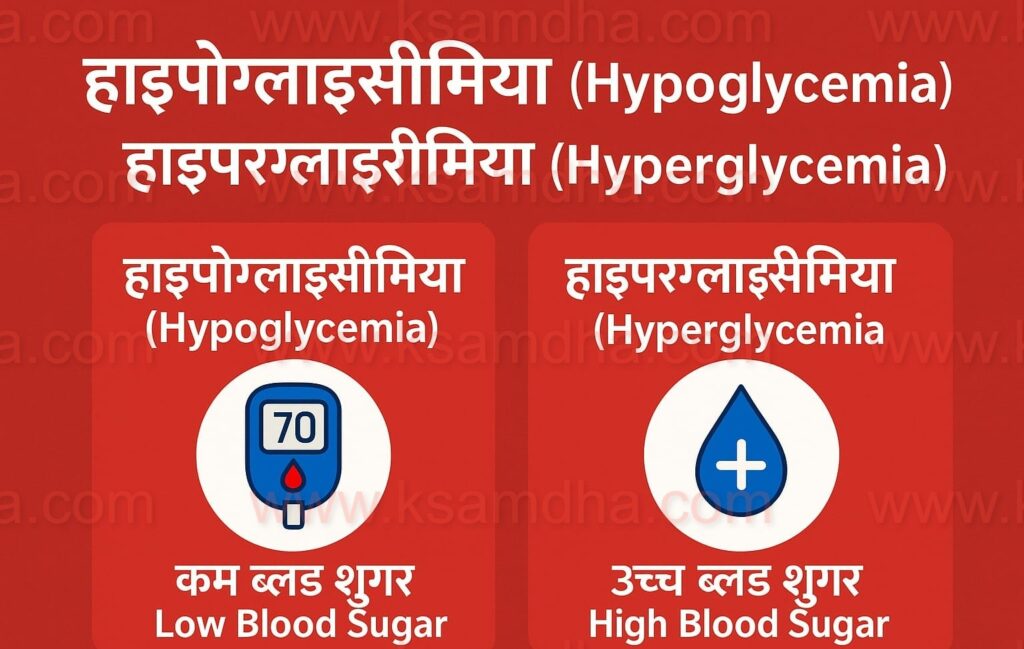Difference Between Hypoglycemia and Hyperglycemia: A Complete Guide
Managing blood sugar levels is crucial for maintaining overall health. Two common conditions related to blood glucose imbalance are Hypoglycemia (low blood sugar) and Hyperglycemia (high blood sugar). Although both are linked to abnormal glucose levels, they have different causes, symptoms, complications, and management strategies. Understanding the difference between hypoglycemia and hyperglycemia is especially important for people with diabetes, caregivers, and anyone aiming to maintain good metabolic health. https://ksamdha.com/
In this article, we will cover:
- What is hypoglycemia?
- What is hyperglycemia?
- Causes of each condition
- Symptoms and warning signs
- Short-term and long-term complications
- Diagnosis methods
- Treatment and management strategies
- Prevention tips
What is Hypoglycemia?
Hypoglycemia refers to a condition where the blood sugar level drops below the normal range. In most cases, blood glucose lower than 70 mg/dL (3.9 mmol/L) is considered hypoglycemia.
It is more common in people with diabetes who are taking insulin or other glucose-lowering medications, but it can also occur in non-diabetic individuals due to fasting, excessive alcohol intake, or certain medical conditions.

Causes of Hypoglycemia
- Excess insulin or diabetes medication
- Skipping or delaying meals
- Excessive exercise without proper food intake
- Alcohol consumption (especially on an empty stomach)
- Certain medical conditions like liver disease or hormonal imbalances
What is Hyperglycemia?
Hyperglycemia is the medical term for high blood sugar, typically above 180 mg/dL (10 mmol/L) after meals or above 130 mg/dL (7.2 mmol/L) while fasting.
It is a hallmark feature of diabetes mellitus (Type 1 and Type 2) but may also occur in people under extreme stress, during infections, or while taking certain medications like steroids.
Causes of Hyperglycemia
- Insufficient insulin or missed medication
- Overeating, especially high-carbohydrate foods
- Lack of physical activity
- Stress and illness
- Hormonal changes (such as during pregnancy or puberty)
- Use of medications that raise blood sugar levels
Symptoms of Hypoglycemia vs Hyperglycemia
Both conditions have distinct warning signs. Recognizing them early helps in preventing serious complications.
Symptoms of Hypoglycemia (Low Blood Sugar)
- Shaking or trembling
- Sweating
- Rapid heartbeat
- Hunger
- Irritability or mood swings
- Blurred vision
- Dizziness or lightheadedness
- Confusion or difficulty concentrating
- Seizures or loss of consciousness (in severe cases)
Symptoms of Hyperglycemia (High Blood Sugar)
- Increased thirst (polydipsia)
- Frequent urination (polyuria)
- Fatigue and weakness
- Headaches
- Blurred vision
- Slow healing of wounds
- Recurrent infections (skin, urinary tract, gums)
- Unexplained weight loss (especially in Type 1 diabetes)
- In extreme cases: diabetic ketoacidosis (DKA) with nausea, vomiting, fruity-smelling breath, and rapid breathing
Complications
If left untreated, both hypoglycemia and hyperglycemia can lead to severe health consequences.
Complications of Hypoglycemia
- Seizures
- Loss of consciousness
- Brain damage (in extreme prolonged cases)
- Sudden accidents or injuries due to fainting
Complications of Hyperglycemia
- Diabetic ketoacidosis (DKA) in Type 1 diabetes
- Hyperosmolar Hyperglycemic State (HHS) in Type 2 diabetes
- Long-term complications: nerve damage, kidney disease, heart disease, stroke, and vision problems (diabetic retinopathy)
Diagnosis
Both conditions are diagnosed using blood glucose monitoring.
- Hypoglycemia: Blood sugar <70 mg/dL
- Hyperglycemia: Fasting blood sugar >130 mg/dL, or post-meal blood sugar >180 mg/dL
- For diabetes management, doctors may recommend continuous glucose monitoring (CGM) or regular HbA1c tests.
Treatment and Management
Hypoglycemia Treatment
- Immediate action: Consume 15–20 grams of fast-acting carbohydrates (glucose tablets, fruit juice, honey, or candy).
- Recheck blood sugar after 15 minutes and repeat if still low.
- If unconscious, emergency glucagon injection may be required.
- Long-term management includes adjusting medication, meal planning, and monitoring.
Hyperglycemia Treatment
- Administer prescribed insulin or diabetes medication.
- Drink water to flush out excess glucose.
- Engage in light physical activity (unless ketones are present).
- Seek medical help if blood sugar remains high despite treatment.
- Long-term management includes dietary control, regular exercise, stress reduction, and medication adherence.
Prevention Tips
Preventing Hypoglycemia
- Eat meals and snacks on time.
- Avoid skipping breakfast or long fasting.
- Monitor blood sugar regularly.
- Adjust insulin dosage based on activity levels.
- Limit alcohol intake.
Preventing Hyperglycemia
- Follow a balanced, low-glycemic diet.
- Exercise regularly.
- Take medications or insulin as prescribed.
- Manage stress with yoga, meditation, or relaxation techniques.
- Regularly check blood glucose levels and HbA1c.
Side-by-Side Comparison Table
| Feature | Hypoglycemia (Low Sugar) | Hyperglycemia (High Sugar) |
| Definition | Blood sugar <70 mg/dL | Blood sugar >180 mg/dL after meals |
| Causes | Excess insulin, missed meals, exercise, alcohol | Too little insulin, overeating, illness, stress |
| Symptoms | Shaking, sweating, hunger, dizziness, confusion | Thirst, frequent urination, fatigue, blurred vision |
| Onset | Rapid (sudden drop) | Gradual (over hours or days) |
| Immediate Risks | Seizures, unconsciousness | Diabetic ketoacidosis, hyperosmolar state |
| Long-term Risks | Brain damage (rare, severe cases) | Nerve, kidney, eye, and heart damage |
| Treatment | Quick carbs, glucagon injection if severe | Insulin, hydration, exercise, medication |
